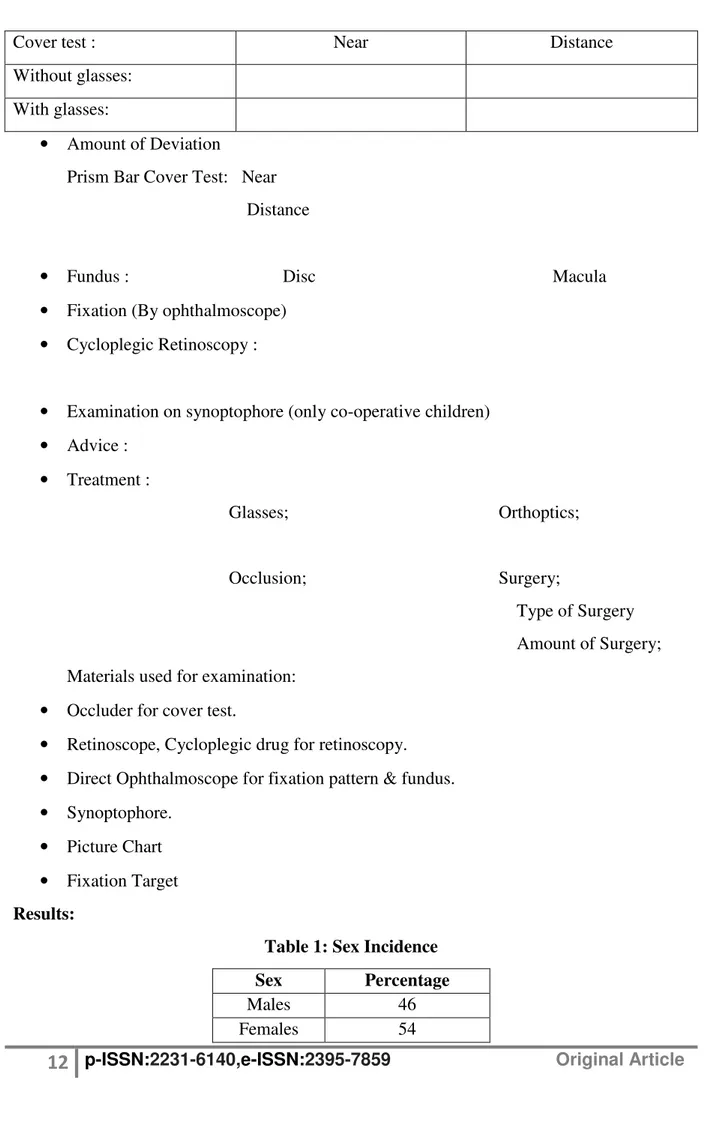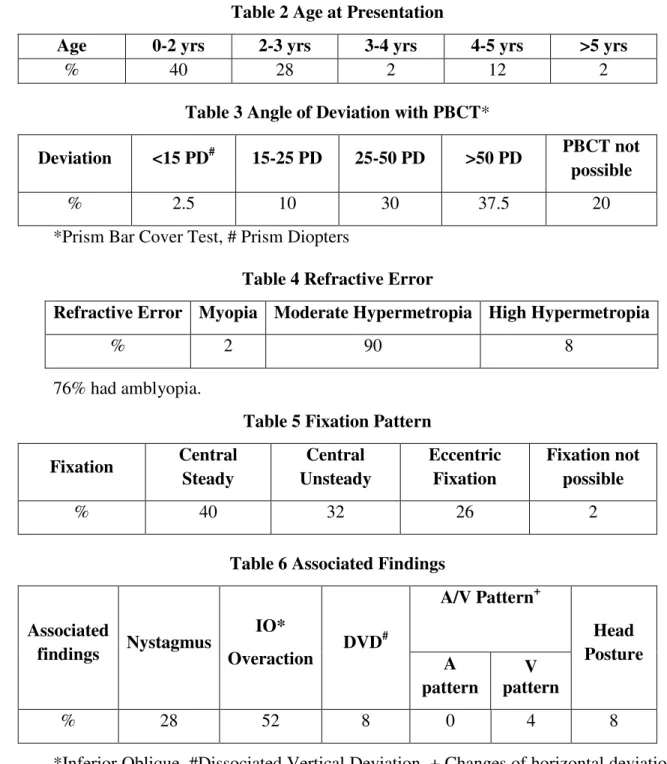10
p-ISSN:2231-6140 *Corresponding Author: Dr Sonam Patel
Email: sonamp068@gmail.com
A Study of Essential Infa
Sonam Patel1*, Snehal Ganatra
1,2Resident doctor, 3, 4 Associa
Ahmedabad.
6 M & J Institute of Ophthalmolo
ABSTRACT
Introduction: Essent
particular attention because of most of the times requires ear study incidence of occurrenc
Materials and Methods: Th
esotropia who attended squint September 2012 & were studi binocular status and amblyop female patients. Most i.e. 62% unilateral deviation. Incidence to moderate hypermetropia, an oblique over-action, 28% had Deviation. Stereopsis was not the age of presentation is be unilateral deviation. Moderate most common association.
Keywords: Essential infantile
Introduction:
Convergent concomit majority of cases may be look of developing binocular refle disruption of these reflexes i consolidated.
Von Noorden has described essential infantile esotropia2 as
• Onset from birth to 6 m
• Large angle ( 30o).
• Stable angle which ma
• Initial alternation with
• Occasionally also very
40,e-ISSN:2395-7859 com
fantile Esotropia.
tra2, Kalpit Shah3, Alka Shah4, Kamini Audich
iate professor, 5 Ex-Director, M & J Institute
logy, Ahmedabad.
ntial infantile esotropia is an entity in sq of its varied etiology and variable associated f early surgical intervention. Aims and Objecti
nce, associated findings and binocular status This is a retrospective study of 50 cases of int clinic of a tertiary referral center between S
died for their age of presentation, squint, cycl opia. Results: Amongst 50 cases 46% were m % cases presented between 1 to 2 years of age. ce of amblyopia was 76%. 2% cases had myo and 8% cases had high hypermetropia. 52% p ad nystagmus, 8% had head posture, 8% had D
ot present in a single case. Conclusion: Our between 1 to 2 years. Amblyopia is common ate hypermetropia is common. Inferior oblique
ile esotropia, squint
itant strabismus in the vast oked upon because of perversion flexes; a minority is due to the s if they have been imperfectly
ed consistent characteristics of as
months.
ay increase with time.
th crossed fixation.
ry early fixation preference.
• Asymmetrical optokinetic n
Original Article
ch5, Praveen Saluja6
te of Ophthalmology,
squint that requires d findings and that it
ctives: Our aim is to us of these patients. f Essential infantile n September 2009 to ycloplegic refraction, male and 54% were ge. 76% patients had yopia, 90% had mild patients had inferior Dissociated Vertical r study assesses that only associated with ue over action is the
11
p-ISSN:2231-6140,e-ISSN:2395-7859 Original ArticleThe eyes of a newborn infant are rarely aligned, especially during the first weeks of life when they frequently shift between alignment and a convergent or divergent position. As the infant grows older, the eye movements become increasingly coordinated, and by the age of 3 months, normal oculomotor behavior is usually established. We performed this study to find out the clinical presentation of children with infantile esotropia.
Materials and methods:
Retrospective data of cases of Essential Infantile Esotropia who attended the squint orthoptic clinic between September 2009 - September 2012 were studied.
The patients were examined according to following Proforma:
• Name :
• Age:
• Sex:
• Address:
• Family History:
• Birth History
• Personal History
• Chief Complaints
• Age of onset :
• Precipitating cause :
• H/O previous treatment taken :
• Exact anomaly observed at the beginning and its variability :
General Examination:
Ophthalmological Examination: -
• Head posture :
• Position of lids:
Vision (if possible) Right Eye Left Eye
Without glasses
With glasses
• Anterior segment :
• Type of Deviation :
12
p-ISSN:2231-6140,e-ISSN:2395-7859 Original ArticleCover test : Near Distance
Without glasses:
With glasses:
• Amount of Deviation
Prism Bar Cover Test: Near
Distance
• Fundus : Disc Macula
• Fixation (By ophthalmoscope)
• Cycloplegic Retinoscopy :
• Examination on synoptophore (only co-operative children)
• Advice :
• Treatment :
Glasses; Orthoptics;
Occlusion; Surgery;
Type of Surgery
Amount of Surgery;
Materials used for examination:
• Occluder for cover test.
• Retinoscope, Cycloplegic drug for retinoscopy.
• Direct Ophthalmoscope for fixation pattern & fundus.
• Synoptophore.
• Picture Chart
• Fixation Target
Results:
Table 1: Sex Incidence
Sex Percentage
Males 46
13
p-ISSN:2231-6140,e-ISSN:2395-7859 Original ArticleTable 2 Age at Presentation
Age 0-2 yrs 2-3 yrs 3-4 yrs 4-5 yrs >5 yrs
% 40 28 2 12 2
Table 3 Angle of Deviation with PBCT*
Deviation <15 PD# 15-25 PD 25-50 PD >50 PD PBCT not
possible
% 2.5 10 30 37.5 20
*Prism Bar Cover Test, # Prism Diopters
Table 4 Refractive Error
Refractive Error Myopia Moderate Hypermetropia High Hypermetropia
% 2 90 8
76% had amblyopia.
Table 5 Fixation Pattern
Fixation Central
Steady
Central Unsteady
Eccentric Fixation
Fixation not possible
% 40 32 26 2
Table 6 Associated Findings
Associated
findings Nystagmus
IO*
Overaction DVD
#
A/V Pattern+
Head Posture A
pattern
V pattern
% 28 52 8 0 4 8
*Inferior Oblique, #Dissociated Vertical Deviation, + Changes of horizontal deviation in up and down gaze resembles alphabets A or V
Family History – 14% cases had family history of squint.
Discussion:
In our study, 46% were males and 54% were females. Similar results were obtained in a study in Italy where 45% were males and 55% were female patients3.
14
p-ISSN:2231-6140,e-ISSN:2395-7859 Original Articleestablished, but the appearance of an esodeviation by 6 months is widely accepted by ophthalmologists as necessary to make the diagnosis4.
Family History was present in 14% of our cases. Certain risk factors have been associated with infantile esotropia. Significant among these are prematurity, family history or secondary ocular history, perinatal or gestational complications, systemic disorders, use of supplemental oxygen as a neonate, use of systemic medications5.
In our study, 98% patients had deviation of more than 25 Prism dioptres (PD) out of which 14% had more than 50PD. In a study conducted in Italy on 576 patients pre-operatively, 36.5% patients had a deviation between 30 and 40 PD, 31.4% between 41 and 59 PD and 32.1% had deviation 60 pD6.
90% of our patients had moderate hypermetropia. 8% had high hypermetropia. The prevalence of high hyperopia was found to be 14.4% (37/256) in infantile esotropia in a study conducted by SSK Ankara Eye Disease Hospital Ankara, Turkey7.
Incidence of Amblyopia was 76% in our study. Normal visual development is rapid during the first six months of life and continues through the first decade. Young children are uniquely sensitive to conditions that interfere with vision and visual development. Amblyopia, or functionally defective development of the central visual system, may be caused by common vision problems such as strabismus, uncorrected refractive errors and deprivation secondary to occlusion. Prematurity is especially associated with eye pathology, including retinopathy of prematurity, amblyopia, strabismus and refractive errors. When detected early, amblyopia and many other childhood vision abnormalities are treatable, but the potential for correction and normal visual development is inversely related to age. Since many affected children are asymptomatic, early detection of abnormal visual function requires effective screening throughout early childhood. Special considerations apply to screening examinations of children born prematurely8.
In our study, the most common association with essential infantile esotropia was inferior oblique overaction i.e. 52%. In a study done by Eustis HS, Nussdorf JD, it was found that Inferior oblique overaction developed in 72% of patients with infantile esotropia but generally is not recognized until the patient is between 2 and 4 years of age9.
Conclusion:
The age of presentation is between 1 to 2 years in children with essential infantile esotropia. Amblyopia is commonly associated with the deviation. Moderate Hypermetropia is common in children of infantile esotropia. Inferior oblique overaction is the most common association.
References:
1. Buckley EG, Kivlin JD et al; Section 6: Pediatric Ophthalmology and Strabismus: Weingeist TA, Liesegang TJ, Grand MG (eds). Basic Science and Clinical Course. 1999, San Francisco : American Academy of Ophthalmology, pp. 74-116
15
p-ISSN:2231-6140,e-ISSN:2395-7859 Original Article3. R. dell’ Omo, A. Salerni, S. Petroni, L. Guccione, G. Savino & A. Dickmann, Impact on deviation in primary position of vertical shift of horizontal rectii muscles. 29th European Strabismological Association meeting, 2004, p. 181
4. Nelson LB, Wagner RS, Simon JW, et al. Congenital esotropia. Surv ophthalmol 1987; 31(6): 363-383.
5. Louwagie CR, Diehl NN, Greenberg AE, Mohney BG. Is the incidence of infantile esotropia declining?: a population-based study from Olmsted County, Minnesota, 1965 to 1994. Arch Ophthalmol. 2009 Feb. 127(2):200-3
6. Adriano Magli, Roberta Carelli, Francesco MatarazzoandDario Bruzzese
Essential infantile esotropia: postoperative motor outcomes and inferential analysis of strabismus surgery : BMC Ophthalmology 2014
7. F Koç, H Özal and E F rat: Is it possible to differentiate early-onset accommodative esotropia from early-onset essential esotropia? Eye (2003) 17, 707–710
8. Monte D. Mills, The Eye in Childhood: Am Fam Physician. 1999 Sep 1; 60(3):907-916.

